Ozone • PM2.5 • Fine/Coarse Speciation • Carbon Monoxide • Nitrogen Dioxide • Sulfur Dioxide • Carbonyl and VOC • PAH • BTEX
Ozone
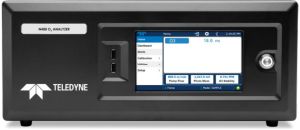
Advanced Pollution Instruments (API) Model N Series 400 Photometric Ozone Analyzer: The continuous ozone monitoring is currently operating in monitoring sites Underhill, Rutland and Bennington, VT. The instrument samples local ambient air quality 24 hours a day, 365 days a year. Averaging intervals of 1, 5, 60 minutes are automatically logged with the data acquisition systems. Reference/Equivalent Method Designation: The Model 400 is designated by EPA as a automated Equivalent Method (EQOA-0992-087) for the measurement of ambient concentrations of ozone. The Model 400 must be and is set up and operated as per the reference designation. Principle Utilized: The instrumental operation utilizes the principle of "Ultraviolet Absorption" that is based on the fact that ozone molecules absorb ultraviolet energy at a known wave length of 254nm. The UV light available for detection is proportional to the amount of ozone in the sample chamber. The unit is setup and operated to monitor ambient ozone concentrations ranging from 0-100 parts per billion to 0-10 parts per million.
Fine Particulates (PM2.5)
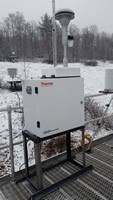 Thermo Scientific Partisol 2025i Sequential Sampler: The 2025i is in monitoring sites Rutland and Underhill, VT. The 2025i samples local ambient air quality every 1-in-3 days for a period of 24 hours. Reference/Equivalent Method Designation: The Model 2025i is designated by EPA as a (Manual Reference Method: RFPS-1298-127) for the measurement of fine particulates. We currently operate using the US EPA VSCC inlet based reference system PM2.5 method. The particulate matter is collected on a Teflon filter that is weighed both before and after sampling.
Thermo Scientific Partisol 2025i Sequential Sampler: The 2025i is in monitoring sites Rutland and Underhill, VT. The 2025i samples local ambient air quality every 1-in-3 days for a period of 24 hours. Reference/Equivalent Method Designation: The Model 2025i is designated by EPA as a (Manual Reference Method: RFPS-1298-127) for the measurement of fine particulates. We currently operate using the US EPA VSCC inlet based reference system PM2.5 method. The particulate matter is collected on a Teflon filter that is weighed both before and after sampling.
 Thermo Scientific Partisol 2000i Sampler: The 2000i in monitoring sites Rutland and Burlington, VT. The 2000i samples local ambient air quality every 1-in-6 day, for a period of 24 hours. Reference/Equivalent Method Designation: The Model 2000i is designated by EPA as a (Manual Reference Method: RFPS-1298-126) for the measurement of fine particulates. This sampler we operate uses the US EPA VSCC inlet based reference system PM2.5 method. The particulate matter is collected on a Teflon filter that is weighed both before and after sampling.
Thermo Scientific Partisol 2000i Sampler: The 2000i in monitoring sites Rutland and Burlington, VT. The 2000i samples local ambient air quality every 1-in-6 day, for a period of 24 hours. Reference/Equivalent Method Designation: The Model 2000i is designated by EPA as a (Manual Reference Method: RFPS-1298-126) for the measurement of fine particulates. This sampler we operate uses the US EPA VSCC inlet based reference system PM2.5 method. The particulate matter is collected on a Teflon filter that is weighed both before and after sampling.
 Teledyne Advanced Pollution Instrumentation Model T640 PM Mass Monitor: The Teledyne Advanced Pollution Instrumentation Model T640 PM mass monitor operates currently at four sites Burlington, Underhill, Rutland and Bennington, VT. Reference/Equivalent Method Designation: The Model T640 is designated by EPA as a (Automatic Equivalent Method: EQPM–0516–236) for the measurement of fine particulates. Principle Utilized: The T640 monitor operates at a volumetric flow rate of 5.0 Lpm, the T640 is a real-time, continuous fine particulate matter (PM2.5) mass monitor that uses scattered light spectrometry for measurement.
Teledyne Advanced Pollution Instrumentation Model T640 PM Mass Monitor: The Teledyne Advanced Pollution Instrumentation Model T640 PM mass monitor operates currently at four sites Burlington, Underhill, Rutland and Bennington, VT. Reference/Equivalent Method Designation: The Model T640 is designated by EPA as a (Automatic Equivalent Method: EQPM–0516–236) for the measurement of fine particulates. Principle Utilized: The T640 monitor operates at a volumetric flow rate of 5.0 Lpm, the T640 is a real-time, continuous fine particulate matter (PM2.5) mass monitor that uses scattered light spectrometry for measurement.
Fine (PM2.5) and Coarse (PM10) Particulate Speciation
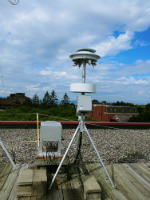 MetOne SASS Sampler: The MetOne SASS unit, which measures PM2.5 mass and PM2.5 chemical speciation, is located in Burlington, VT at the Zampieri State Office Building and is part of the EPA Speciation Trends Network (STN). The MetOne SASS sampling frequency is a 1-in-3 day sampling period. Data is validated on a monthly basis when reports are received from the contract laboratory (Research Triangle Institute).
MetOne SASS Sampler: The MetOne SASS unit, which measures PM2.5 mass and PM2.5 chemical speciation, is located in Burlington, VT at the Zampieri State Office Building and is part of the EPA Speciation Trends Network (STN). The MetOne SASS sampling frequency is a 1-in-3 day sampling period. Data is validated on a monthly basis when reports are received from the contract laboratory (Research Triangle Institute).
 IMPROVE Sampler: The IMPROVE (Interagency Monitoring of Protected Visual Environments) sampler, which measures PM2.5 mass, PM10 mass and PM2.5 chemical speciation, has a sampling frequency of 1-in-3 day sampling schedule in Underhill, VT at the Proctor Maple Research Facility. Data is validated at the Crocker Nuclear Laboratory at UC-Davis and is then reported to the operating site usually within a 6-month period.
IMPROVE Sampler: The IMPROVE (Interagency Monitoring of Protected Visual Environments) sampler, which measures PM2.5 mass, PM10 mass and PM2.5 chemical speciation, has a sampling frequency of 1-in-3 day sampling schedule in Underhill, VT at the Proctor Maple Research Facility. Data is validated at the Crocker Nuclear Laboratory at UC-Davis and is then reported to the operating site usually within a 6-month period.
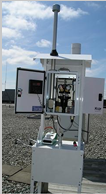
Carbon Monoxide (CO)
 Advanced Pollution Instruments (API) Model T300/ T300U Gas Filter Correlation Carbon Monoxide Analyzer: The T300 carbon monoxide anaylzer operates in Burlington and Rutland, VT and the T300U carbon monoxide anaylzer operates in Underhill, VT. The carbon monoxide instrument samples local ambient air quality 24 hours a day, 365 days a year. Carbon monoxide averaging intervals of 1, 5, 60 minutes are automatically logged with the data acquisition systems. Reference/Equivalent Method Designation: The Model T300/ T300U is designated by EPA as a Reference Method (RFCA-1093-093) for the measurement of ambient concentrations of carbon monoxide. The Model T300/T300U must be and is set up and operated as per the reference designation. Principle Utilized The instrumental operation utilizes the principle of "Gas Filter Correlation" that is based on the fact that carbon monoxide molecules absorb infrared radiation at a know spectral wavelength of 4.6 mm. The infrared absorption characteristic is a non-linear technique. The unit is setup and operated to monitor ambient concentrations range from 10 parts per million to 50 parts per million.
Advanced Pollution Instruments (API) Model T300/ T300U Gas Filter Correlation Carbon Monoxide Analyzer: The T300 carbon monoxide anaylzer operates in Burlington and Rutland, VT and the T300U carbon monoxide anaylzer operates in Underhill, VT. The carbon monoxide instrument samples local ambient air quality 24 hours a day, 365 days a year. Carbon monoxide averaging intervals of 1, 5, 60 minutes are automatically logged with the data acquisition systems. Reference/Equivalent Method Designation: The Model T300/ T300U is designated by EPA as a Reference Method (RFCA-1093-093) for the measurement of ambient concentrations of carbon monoxide. The Model T300/T300U must be and is set up and operated as per the reference designation. Principle Utilized The instrumental operation utilizes the principle of "Gas Filter Correlation" that is based on the fact that carbon monoxide molecules absorb infrared radiation at a know spectral wavelength of 4.6 mm. The infrared absorption characteristic is a non-linear technique. The unit is setup and operated to monitor ambient concentrations range from 10 parts per million to 50 parts per million.
Nitrogen Dioxide (NO2)
 Advanced Pollution Instruments (API) Model T Series 200 Chemiluminescence Oxides of Nitrogen Analyzer: The T200 operates two continuous oxides of nitrogen analyzers in Burlington and Rutland, VT. The instrument samples local ambient air quality 24 hours a day, 365 days a year. Averaging intervals of 1, 5, 60 minutes are automatically logged with the data acquisition systems. Reference/Equivalent Method Designation: The Model T200 is designated by EPA as a automated Reference Method (RFNA-1289-074) for the measurement of ambient concentrations of nitric oxide. The Model T200 must be and is set up and operated as per the reference designation. Principle Utilized: The instrumental operation utilizes the principle of "Chemiluminescence" that is based on the rapid gas phase reaction of nitric oxide molecules and ozone molecules. Light emissions from the excited nitrogen dioxide molecule to it's lower ground state by a photomultiplier tube (PMT). The unit is setup and operated to monitor ambient NO and NO2 concentrations that range from 0-50 parts per billion to 0-20 parts per million with a detection limit of 0.4 ppb.
Advanced Pollution Instruments (API) Model T Series 200 Chemiluminescence Oxides of Nitrogen Analyzer: The T200 operates two continuous oxides of nitrogen analyzers in Burlington and Rutland, VT. The instrument samples local ambient air quality 24 hours a day, 365 days a year. Averaging intervals of 1, 5, 60 minutes are automatically logged with the data acquisition systems. Reference/Equivalent Method Designation: The Model T200 is designated by EPA as a automated Reference Method (RFNA-1289-074) for the measurement of ambient concentrations of nitric oxide. The Model T200 must be and is set up and operated as per the reference designation. Principle Utilized: The instrumental operation utilizes the principle of "Chemiluminescence" that is based on the rapid gas phase reaction of nitric oxide molecules and ozone molecules. Light emissions from the excited nitrogen dioxide molecule to it's lower ground state by a photomultiplier tube (PMT). The unit is setup and operated to monitor ambient NO and NO2 concentrations that range from 0-50 parts per billion to 0-20 parts per million with a detection limit of 0.4 ppb.
Nitrogen Oxide (NOy)
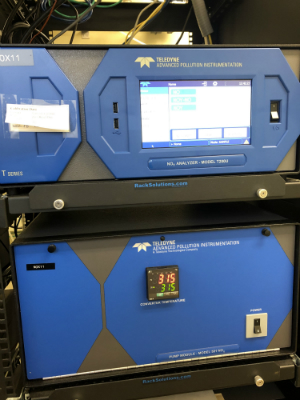
API T200U Total Reactive Nitrogen Analyzer: The API T200U trace level instrument is located in Underhill, VT. The instrument samples local ambient air quality 24 hours a day, 365 days a year. Averaging intervals of 1, 5, 60 minutes are automatically logged with the data acquisition systems. Reference/Equivalent Method Designation: This method is utilized to comply with 40 CFR Part 58 Appendix C requiring NCORE monitoring. Principle Utilized: The API T200U NOy analyzer combines microprocessor control with chemiluminescence detection to provide accurate measurements of NO and NOy in the range of 0-50 ppb with a detection limit of 0.5 ppb.
Sulfur Dioxide (SO2)
 Advanced Pollution Instruments (API) Model T100 UV Fluorescence SO2 Analyzer: There are currently two anaylzers that monitor SO2. The T100 anaylzer is located in Rutland, VT. The T100U, which is our trace level anaylzer is located in Underhill, VT. The instrument samples local ambient air quality 24 hours a day, 365 days a year. Averaging intervals of 1, 5, 60 minutes are automatically logged with the data acquisition systems. Reference/Equivalent Method Designation: The Model T100 is designated by EPA as a automated Equivalent Method (EQSA-0495-100) for the measurement of ambient concentrations of sulfur dioxide. The Model T100 must be and is set up and operated as per the equivalency designation. The T100U anaylzer is designated as a reference method as defined in 40 CFR Part 53. Principle Utilized: The instrumental operation utilizes the principle of "Pulsed Fluorescence" that is based on the fact that sulfur dioxide molecules absorb fluorescent energy, producing electronically excited SO2 molecule with a known spectral decay rate to the ground state. The fluorescence emitted by the reaction is detected by a photo multiplier tube and the signal is converter proportionally to a electronic output signal. The T100 is setup and operated to monitor ambient concentration range from 0-50 parts per billion to 10 parts per million. The T100U is setup and operated to monitor ambient concentration range from 0-5 parts per billion.
Advanced Pollution Instruments (API) Model T100 UV Fluorescence SO2 Analyzer: There are currently two anaylzers that monitor SO2. The T100 anaylzer is located in Rutland, VT. The T100U, which is our trace level anaylzer is located in Underhill, VT. The instrument samples local ambient air quality 24 hours a day, 365 days a year. Averaging intervals of 1, 5, 60 minutes are automatically logged with the data acquisition systems. Reference/Equivalent Method Designation: The Model T100 is designated by EPA as a automated Equivalent Method (EQSA-0495-100) for the measurement of ambient concentrations of sulfur dioxide. The Model T100 must be and is set up and operated as per the equivalency designation. The T100U anaylzer is designated as a reference method as defined in 40 CFR Part 53. Principle Utilized: The instrumental operation utilizes the principle of "Pulsed Fluorescence" that is based on the fact that sulfur dioxide molecules absorb fluorescent energy, producing electronically excited SO2 molecule with a known spectral decay rate to the ground state. The fluorescence emitted by the reaction is detected by a photo multiplier tube and the signal is converter proportionally to a electronic output signal. The T100 is setup and operated to monitor ambient concentration range from 0-50 parts per billion to 10 parts per million. The T100U is setup and operated to monitor ambient concentration range from 0-5 parts per billion.
Combined Carbonyl & VOC
 ATEC Model 2200 Combined Cartridge/ Canister Sampler: The State of Vermont AQCD operates sampling for these methods in Burlington, Rutland and Underhill. Reference/Equivalent Method Designation: Carbonyl compound sampling and analysis is performed following EPA method TO11A from EPA's Compendium of Methods for the Determination of Toxic Organic Compounds in Ambient Air EPA/625/R-96/010b. Principle Utilized: Carbonyl samples are collected using Waters Sep-Pak DNPH-silica cartridges (2,4-Dinitrophenylhydrazine) and an ATEC Model 2200 Cartridge/ VOC sampler. Carbonyl samples are collected over 24-hour periods (midnight to midnight) . DNPH cartridges are transported at 4°C to the laboratory for analysis.
ATEC Model 2200 Combined Cartridge/ Canister Sampler: The State of Vermont AQCD operates sampling for these methods in Burlington, Rutland and Underhill. Reference/Equivalent Method Designation: Carbonyl compound sampling and analysis is performed following EPA method TO11A from EPA's Compendium of Methods for the Determination of Toxic Organic Compounds in Ambient Air EPA/625/R-96/010b. Principle Utilized: Carbonyl samples are collected using Waters Sep-Pak DNPH-silica cartridges (2,4-Dinitrophenylhydrazine) and an ATEC Model 2200 Cartridge/ VOC sampler. Carbonyl samples are collected over 24-hour periods (midnight to midnight) . DNPH cartridges are transported at 4°C to the laboratory for analysis.
The Vermont Agriculture & Environmental Lab performs the Carbonyl cartridge sample extraction and subsequent analysis for 14 compounds using a Waters High Performance Liquid Chromatograph (HPLC) with a multi-wavelength UV detector. VOC sampling and analysis is performed following EPA method TO15 from EPA's Compendium of Methods for the Determination of Toxic Organic Compounds in Ambient Air EPA/625/R-96/010b. VOC samples are collected in specially treated 6-liter Silcosteel stainless steel canisters (which have been pre-cleaned and certified prior to each use) using ATEC Model 2200 Cartridge/Canister Sampler. VOC samples are collected over 24-hour periods (midnight to midnight). Canister samples are transported to the laboratory for analysis.
The Vermont DEC performs the VOC canister sample analysis for 59 compounds using an ENTECH model 7100 Cryogenic Concentrator Microscale Purge and Trap Unit (to acquire and condition the sample) and a Hewlett-Packard (HP) 6890 gas chromatograph/5973 mass spectrometer (GC/MS) with the mass selective detector.
PAH (Semi Volatile)
 PAH (semi-volatile) TISCH PUF+: The PAH is operating in Underhill, VT. Samples are collected for 24-hours (midnight to midnight) following EPA's 1-in-6 day sampling schedule. Reference/Equivalent Method Designation: Poly-aromatic hydrocarbon (PAH) sampling and analysis is performed following EPA method TO-13A from EPA's Compendium of Methods for the Determination of Toxic Organic Compounds in Ambient Air EPA/625/R-96/010b and the ASTM D6209-98. Principle Utilized: The TISCH PUF+ sampler is used to collect ambient air samples for determining vapor and particulate concentrations of PAHs (semi-volatile organic compounds such as naphthalene and benzo [a] pyrene). This sampler is comprised of a small outdoor aluminum shelter which houses a vacuum/blower motor and a programmable microprocessor timer/controller which automatically starts and stops sample collection, controls air flow through the sampling module and collects and stores sample-related information. Approximately 200 m3 of air is sampled through a special module containing a polyurethane foam (PUF) plug insert combined with a special adsorbent (XAD-2: styrene-divinylbenzene resin) and a 104 mm quartz-fiber filter. Samples are kept cool during transport/shipment to the laboratory for analysis. The EPA contract lab performs the PAH/semi-volatile analysis for 22 compounds using a Soxhlet extraction and gas chromatography/mass spectrometry (GS/MS).
PAH (semi-volatile) TISCH PUF+: The PAH is operating in Underhill, VT. Samples are collected for 24-hours (midnight to midnight) following EPA's 1-in-6 day sampling schedule. Reference/Equivalent Method Designation: Poly-aromatic hydrocarbon (PAH) sampling and analysis is performed following EPA method TO-13A from EPA's Compendium of Methods for the Determination of Toxic Organic Compounds in Ambient Air EPA/625/R-96/010b and the ASTM D6209-98. Principle Utilized: The TISCH PUF+ sampler is used to collect ambient air samples for determining vapor and particulate concentrations of PAHs (semi-volatile organic compounds such as naphthalene and benzo [a] pyrene). This sampler is comprised of a small outdoor aluminum shelter which houses a vacuum/blower motor and a programmable microprocessor timer/controller which automatically starts and stops sample collection, controls air flow through the sampling module and collects and stores sample-related information. Approximately 200 m3 of air is sampled through a special module containing a polyurethane foam (PUF) plug insert combined with a special adsorbent (XAD-2: styrene-divinylbenzene resin) and a 104 mm quartz-fiber filter. Samples are kept cool during transport/shipment to the laboratory for analysis. The EPA contract lab performs the PAH/semi-volatile analysis for 22 compounds using a Soxhlet extraction and gas chromatography/mass spectrometry (GS/MS).
BTEX (Gas Chromatograph)
 Syntech Spectras GC955 series 600 Gas Chromatograph: The semi-continuous BTEX (benzene, toluene, ethylbenzene, xylene) monitoring site in Burlington, VT. The BTEX instrument samples local ambient air quality 24 hours a day, 365 days a year. BTEX 15 minute averaging intervals are automatically written to a log file on the instrument. Principle Utilized: The unit is setup and operated to monitor ambient concentrations up to 5 parts per billion. Principle Utilized The instrumental operation utilizes the principle of "Gas Chromatography" with a "Photoionization Detector" (GC/PID). During each 15-minute cycle, the sampling cylinder/piston draws a total of 150 cc of ambient air sample through a preconcentrator at set intervals. Simultaneously, the previous 15 minute sample undergoes a 15 minute analysis cycle. The sample is thermally desorbed from the preconcentrator into a stripper column and then into the analysis column. Once BTEX compounds move through the stripper column (after injection mode) the 10-port valve switches and back flushes the remaining VOCs from the stripper column. The BTEX compounds are separated in the column and exit to the PID for measurement at specific retention times. The PID ionizes the molecules using ultraviolet radiation. The charged gas ions flow to charged electrodes in the sensor and produce a current which is measured and displayed as a concentration on the meter. The greater the concentration of the component, the more ions are produced, and the greater the current.
Syntech Spectras GC955 series 600 Gas Chromatograph: The semi-continuous BTEX (benzene, toluene, ethylbenzene, xylene) monitoring site in Burlington, VT. The BTEX instrument samples local ambient air quality 24 hours a day, 365 days a year. BTEX 15 minute averaging intervals are automatically written to a log file on the instrument. Principle Utilized: The unit is setup and operated to monitor ambient concentrations up to 5 parts per billion. Principle Utilized The instrumental operation utilizes the principle of "Gas Chromatography" with a "Photoionization Detector" (GC/PID). During each 15-minute cycle, the sampling cylinder/piston draws a total of 150 cc of ambient air sample through a preconcentrator at set intervals. Simultaneously, the previous 15 minute sample undergoes a 15 minute analysis cycle. The sample is thermally desorbed from the preconcentrator into a stripper column and then into the analysis column. Once BTEX compounds move through the stripper column (after injection mode) the 10-port valve switches and back flushes the remaining VOCs from the stripper column. The BTEX compounds are separated in the column and exit to the PID for measurement at specific retention times. The PID ionizes the molecules using ultraviolet radiation. The charged gas ions flow to charged electrodes in the sensor and produce a current which is measured and displayed as a concentration on the meter. The greater the concentration of the component, the more ions are produced, and the greater the current.

